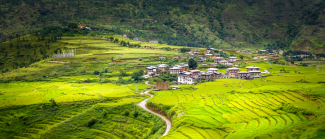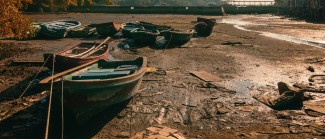On paper, fish is a small part of the economy of The Gambia. In this small West African country surrounded by Senegal on all sides save for an 80-kilometer Atlantic coastline, the fisheries sector contributes only about 2% of Gross Domestic Product (GDP), far behind agriculture and services.
On the plate, however, fish is a big and important chunk of food security. The average Gambian eats around 29 kilograms of fish every year, more than the world average of 20kg.
Fish is caught off the country’s continental shelf of about 4,000 square kilometers, including a 200-nautical mile Exclusive Economic Zone, as well as in The Gambia River, which runs through the course of the country. Varieties like bonga, round and flat sardinella and other small pelagic fishes are consumed locally or within the region.
Higher-value varieties like sole, snappers, shrimp, cuttlefish, octopus and oysters, feed into a small but important export-oriented segment of the fishing industry. Fish-related activities are the main source of income for communities living near the coastline. The sector supports the livelihoods of more than 200,000 people and is particularly important to women who make up 80 percent of fish processors and half of small-scale fish traders.
Agriculture contributing to 30 percent of GDP and employing seven out of every 10 Gambians, according to government officials. However, it remains mostly subsistence in nature, and The Gambia remains a net food importer, including of its staple, rice. The sector is also vulnerable to drought and the negative effects of climate change.
The Gambia’s Trade Policy Review in 2018 highlighted the heavy reliance on services, particularly tourism, and the need to diversify the economy. An analysis of the fisheries industry in The Gambia that focused on trade, value addition and social inclusiveness with a focus on women found that the sector is a critical entry point for poverty alleviation in the country. It provides a source of revenue and foreign exchange and contributes to food security and incomes, especially for the poor.
The government of The Gambia has, with the support of partners including the Enhanced Integrated Framework (EIF) and the Food and Agriculture Organization (FAO), been working to improve productivity and standards in the fisheries sector.
Support from the EIF has been multi-faceted. At the policy level, it has supported the mainstreaming of trade in the national development plan, and identifying priorities through a diagnostic study of the private sector, says Ousman Bojang, the director in charge of trade at the Ministry of Trade, Industry, Regional Integration and Employment.
A national trade facilitation committee is at the heart of efforts to make eCommerce assessments, help The Gambia access climate change and trade-related financing, as well as develop a strategy to take advantage of the African Growth and Opportunity Act, which offers access to the American market.
Other interventions have been more practical and aimed at the grassroots. Artisanal fishing is responsible for 90 percent of the output, thus efforts to improve the sector have targeted small scale farmers, processors and traders.
One challenge is climate change which affects fishing industries by raising ocean temperatures, increasing acidification and lowering oxygen levels which, together, affect marine life.
An investigation into The Gambia’s fishing industry revealed that if nothing is done to counter the negative effects of climate change, “shellfish won't be able to develop shells properly; harmful algae blooms will proliferate, choking off coastal fisheries; and populations of fish will continue moving to cooler waters, leaving behind the fishing communities and economies that have depended on them for centuries.”
One intervention has targeted reducing the carbon footprint from The Gambia’ fishing industry, which relies on smoke-curing to preserve produce.
Starting in 2017, EIF has worked with the government of The Gambia on a smokehouse project in Tanji fishing village on the Atlantic coastline. Smoking fish helps to preserve it and takes place in homes and at landing sites. The new facility is more energy efficient and by reducing the amount of firewood used, protects forest cover from depletion.
“There is a high reduction in the amount of wood used and the amount of smoke produced,” says Babanding Kanyi from the Department of Fisheries. Reducing the carbon footprint from the fisheries sector is important due to the negative effects climate change has on it.
Other interventions have targeted improvements to the fish value chain. In 2016 training was provided to 200 women in post-harvest handling, good management practices, as well as hygiene and sanitation so that fish exporters can meet standards in key markets such as the European Union.
Between January 2022 and June 2023, a $75,000 project will supply 20 insulated ice boxes to women fish traders at different landing sites. “The insulation helps prolong the shelf-life of the fish,” says Mr Kanyi, “giving them more time to sell it either fresh or to deliver it to the smokehouse.”
Targeting women is intentional. Adding a gender dimension to aid for trade ensures that women are not left behind. In The Gambia where they play key roles in processing and trading, strengthening their hand acts as leverage to lift the whole fisheries sector.
The Gambia’s most recent trade policy review identified priority areas for investment including aquaculture, fish and shrimp farming, fishing and industrial scale fish processing. The opportunity is clear; while fish remains a small part of overall GDP, fish and fish products account for more than 15 percent of merchandise export earnings, according to the Department of Fisheries.
Much of the fish caught off the coast of The Gambia is landed in foreign ports. It is processed, packaged and labelled as originating from those countries. A new fisheries jetty in the capital, Banjul, with ancillary facilities for fish handling and refrigeration, will increase the volume of fish landed in the country and reflect production figures more accurately.
Improving productivity from the artisanal subsector, which provides the raw material for the industrial processing plants, will increase the amount of product available. Higher standards and value addition will increase the export earnings, employment and income for Gambians, and raise the fishing sector’s share of GDP. Doing it in a climate-smart manner will ensure that this growth is sustainable.
----
This article is part of a series dedicated to climate and trade.
If you would like to reuse any material published here, please let us know by sending an email to EIF Communications: eifcommunications@wto.org.



